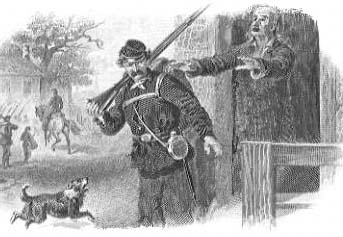

Historical Tales | News | Vampires | Zombies | Werewolves
Virtual Academy | Weapons | Links | Forum
 |
 |
Historical Tales | News | Vampires | Zombies | Werewolves Virtual Academy | Weapons | Links | Forum |
Return to Vampires vs. Zombies
 |
|
Key West; 1935: zombified corpses being prepared for disposal |
Within 48 hours, FVZA troops from all over the South converged on Key West in a variety of seacraft. Soon after, they established a beachhead on the south side of the island and went about the process of extermination. It took up to three weeks to secure the entire island, wherein a total of 3,500 people were infected and destroyed—an enormous number considering that there was a zombism vaccine available at the time.
 |
| A zombie attacks a Union soldier in Vicksburg |
On June 17, city residents spotted the first zombie. Within a few days, dozens were wandering about. Still, this development hardly worried the 30,000 Confederate troops protecting the city—they even entertained themselves by conducting target practice on the zombies. Unfortunately, with their supply lines cut off, the Confederate troops soon ran out of ammunition, and the zombies kept coming. To this day, Southerners claim that the Union let the zombic plague continue out of pure malice.
In any case, when Union forces entered the city on July 3, hundreds of zombies were roaming the streets, many in Confederate Army uniforms. As there was no FVZA at this time, the Union soldiers had to do all the killing themselves, and they quickly found out that zombies, unlike soldiers, do not surrender. In the end, an estimated 2,000 people were infected and destroyed at Vicksburg—almost as many as were killed during the Battle of Bull Run.
 |
| Queen Lili'uokalani |
Queen Lili'uokalani ascended to the throne in 1891 and promptly enacted a series of measures designed to weaken the influence of the sugar growers. However, her mind was soon occupied by different matters: in August of 1892, a zombic plague—which began among Chinese laborers in the sugarcane fields of Oahu—had spread to Honolulu. Wave after wave of zombies came staggering out of the jungle, forcing desperate islanders to board outrigger canoes and flee to neighboring islands.
Despite her fear of losing independence, the queen had no choice but to ask the United States for help. A detachment of FVZA troops arrived in the fall and quickly wrested control of the city from the zombies. But the surrounding countryside proved more difficult to clear, so more FVZA agents were called in. The sugar growers took advantage of the chaos and panic by launching a coup, and the queen was deposed in January of 1893.
Hawaii was eventually annexed by the United States in 1898, but they did not become the 50th star on the American flag until August 21, 1959. There has long been suspicion that the sugar growers let the plague go in order to destabilize the queen, a notion strengthened by the fact that the top growers left Hawaii shortly after the outbreak began. Whatever the case may be, Hawaii's 1892 zombism outbreak killed just under 2,000 people, making it the third-worst in U.S. history.